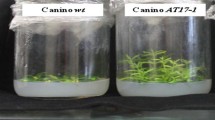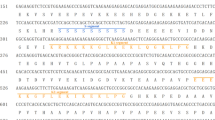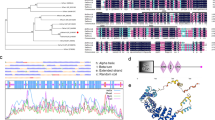Abstract
Agricultural production is greatly affected by environmental stresses, such as cold, drought and high-salinity. It is possible to produce tolerant genotypes by transferring genes encoding protective proteins or enzymes from other organisms. In this regard, the current study was aimed to clone a novel OeSRC1 gene identified during the transcriptome profiling of olives (Olea europaea L.) and to investigate the function of this gene in tobacco plants. Functional evaluation of OeSRC1 gene in putative transgenic tobacco plants were carried out under drought, cold and salt stress conditions by using molecular and biochemical tools. It was observed that the transgenic tobacco plants exhibited higher seed germination and survival rates, better root and shoot growth under cold, salt and drought stress treatments compared to wild type plants. Our results also demonstrated that, under stress conditions, transgenic plants accumulated more free proline while no significant changes were observed regarding electrolyte leakage. Ascorbate peroxidase activity of OeSRC1-overexpressing plants was higher than those of the WT plants under different stress conditions. The overall results demonstrate the explicit role of OeSRC1 gene in conferring multiple abiotic stress tolerance at the whole-plant level. The multifunctional role of olive OeSRC1 gene looks good to enhance environmental stress tolerance in diverse plants.








Similar content being viewed by others
References
Dubouzet JG, Sakuma Y, Ito Y, Kasuga M, Dubouzet EG, Miura S et al (2003) OsDREB genes in rice, Oryza sativa L., encode transcription activators that function in drought-, high-salt- and cold-responsive gene expression. Plant J 33:751–763
Holmberg N, Bulow L (1998) Improving stress tolerance in plants by gene transfer. Trends Plant Sci 3:61–66
Sahoo DP, Kumar S, Mishra S, Kobayashi Y, Panda SK, Sahoo L (2016) Enhanced salinity tolerance in transgenic mungbean overexpressing Arabidopsis antiporter (NHX1) gene. Mol Breed 36(10):144
Larcher W (2003) Physiological plant ecology: ecophysiology and stress physiology of functional groups. Springer, New York, p 513
Bray EA, Bailey-Serres J, Weretilnyk E (2000) Responses to abiotic stresses. In: Buchanan B, Gruissem W, Jones R (eds) Biochemistry and molecular biology of plants. American Society of Plant Physiologists, Rockville, pp 1158–1249
Harris D, Tripathi R, Joshi A (2002) On-farm seed priming to improve crop establishment and yield in dry direct-seeded rice. In: Mortimer M, Pandey S, Wade L, Tuong TP, Lopes K, Hardy B (eds) Direct seeding: research strategies and opportunities. International Research Institute, Manila, pp 231–240
Taiz L, Zeiger E (2010) Plant physiology. Sinauer Associates Inc, Sunderland, p 782
Yadav RS, Hash CT, Bidinger FR, Devos KM, Howarth CJ (2004) Genomic regions associated with grain yield and aspects of post-flowering drought tolerance in pearl millet across stress environments and tester background. Euphytica 136:265–277
Machado RMA, Serralheiro RP (2017) Soil salinity: effect on vegetable crop growth. Management practices to prevent and mitigate soil salinization. Horticulturae 3(2):30
Hasegawa PM, Bressan RA, Zhu JK, Bohnert HJ (2000) Plant cellular and molecular responses to high salinity. Annu Rev Plant Phys 51:463–499
Parida AK, Das AB (2005) Salt tolerance and salinity effects on plants: a review. Ecotoxicol Environ Saf 60:324–349
Zhu XY, Li XP, Zou Y, Chen WX, Lu WJ (2012) Cloning, characterization and expression analysis of ∆1-pyrroline-5-carboxylate synthetase (P5CS) gene in harvested papaya (Carica papaya) fruit under temperature stress. Food Res Int 49:272–279
Guerzoni JTS, Belintani NG, Moreira RMP, Hoshino AA, Domingues DS, Bespalhok Filho JC et al (2014) Stress-induced Delta 1-pyrroline-5-carboxylate synthetase (P5CS) gene confers tolerance to salt stress in transgenic sugarcane. Acta Physiol Plant 36:2309–2319
Ghanti SKK, Sujata KG, Kumar BMV, Karba NN, Reddy KJ, Rao MS et al (2011) Heterologous expression of P5CS gene in chickpea enhances salt tolerance without affecting yield. Biol Plant 55:634–640
Cong LL, Zhang XQ, Yang FY, Liu SJ, Zhang YW (2014) Isolation of the P5CS gene from reed canary grass and its expression under salt stress. Genet Mol Res 13:9122–9133
Li J, Phan T-T, Li Y-R, Xing Y-X, Yang L-T (2018) Isolation, transformation and overexpression of sugarcane SoP5CS gene for drought tolerance improvement. Sugar Tech 20:464–473
Zhu M, Meng X, Cai J, Li G, Dong T, Li Z (2018) Basic leucine zipper transcription factor SlbZIP1 mediates salt and drought stress tolerance in tomato. BMC Plant Biol 18:83
Jin X, Xue Y, Wang R, Xu R, Bian L, Zhu B et al (2013) Transcription factor OsAP21 gene increases salt/drought tolerance in transgenic Arabidopsis thaliana. Mol Biol Rep 40:1743–1752
Wang N-N, Xu S-W, Sun Y-L, Liu D, Zhou L, Li Y et al (2019) The cotton WRKY transcription factor (GhWRKY33) reduces transgenic Arabidopsis resistance to drought stress. Sci Rep 9:724
Thirumalaikumar VP, Devkar V, Mehterov N, Ali S, Ozgur R, Turkan I et al (2018) NAC transcription factor JUNGBRUNNEN1 enhances drought tolerance in tomato. Plant Biotechnol J 16:354–366
Chen WJ, Zhu T (2004) Networks of transcription factors with roles in environmental stress response. Trends Plant Sci 9:591–596
Magwanga RO, Lu P, Kirungu JN, Lu HJ, Wang XX, Cai XY et al (2018) Characterization of the late embryogenesis abundant (LEA) proteins family and their role in drought stress tolerance in upland cotton. BMC Genet 19(1):6
Close TJ (1997) Dehydrins: a commonalty in the response of plants to dehydration and low temperature. Phys Plant 100:291–296
Hara M, Monna S, Murata T, Nakano T, Amano S, Nachbar M et al (2016) The Arabidopsis KS-type dehydrin recovers lactate dehydrogenase activity inhibited by copper with the contribution of His residues. Plant Sci 245:135–142
Amara I, Capellades M, Ludevid MD, Pagès M, Goday A (2013) Enhanced water stress tolerance of transgenic maize plants over-expressing LEA Rab28 gene. J Plant Physiol 170:864–873
RoyChoudhury A, Roy C, Sengupta DN (2007) Transgenic tobacco plants overexpressing the heterologous lea gene Rab16A from rice during high salt and water deficit display enhanced tolerance to salinity stress. Plant Cell Rep 26:1839–1859
Cheng Z, Targolli J, Huang X, Wu R (2002) Wheat LEA genes, PMA80 and PMA1959, enhance dehydration tolerance of transgenic rice (Oryza sativa L.). Mol Breed 10:71–82
Liu Y, Song QP, Li DX, Yang XH, Li DQ (2017) Multifunctional roles of plant dehydrins in response to environmental stresses. Front Plant Sci 8:1018
Svensson J, Ismail AM, Tapio Palva E, Close TJ (2002) Dehydrins. In: Storey KB, Storey JM (eds) Cell and molecular response to stress. Elsevier, Amsterdam, pp 155–171
Koag M-C, Wilkens S, Fenton RD, Resnik J, Vo E, Close TJ (2009) The K-segment of maize DHN1 mediates binding to anionic phospholipid vesicles and concomitant structural changes. Plant Physiol 150:1503–1514
Hanin M, Brini F, Ebel C, Toda Y, Takeda S, Masmoudi K (2011) Plant dehydrins and stress tolerance. Plant Signal Behav 6:1503–1509
Kavas M, Baloglu MC, Yucel AM, Oktem HA (2016) Enhanced salt tolerance of transgenic tobacco expressing a wheat salt tolerance gene. Turk J Biol 40:727–735
Liu X, Hua X, Guo J, Qi D, Wang L, Liu Z et al (2008) Enhanced tolerance to drought stress in transgenic tobacco plants overexpressing VTE1 for increased tocopherol production from Arabidopsis thaliana. Biotechnol Lett 30:1275–1280
Svab Z, Hajdukiewicz P, Maliga P (1990) Stable transformation of plastids in higher-plants. Proc Natl Acad Sci USA 87:8526–8530
Livak KJ, Schmittgen TD (2001) Analysis of relative gene expression data using real-time quantitative PCR and the 2−∆∆CT) method. Methods 25:402–408
Hodges DM, DeLong JM, Forney CF, Prange RKJP (1999) Improving the thiobarbituric acid-reactive-substances assay for estimating lipid peroxidation in plant tissues containing anthocyanin and other interfering compounds. Planta 207:604–611
Bates LS, Waldren RP, Teare ID (1973) Rapid determination of free proline for water-stress studies. Plant Soil 39:205–207
Akcay UC, Ercan O, Kavas M, Yildiz L, Yilmaz C, Oktem HA et al (2010) Drought-induced oxidative damage and antioxidant responses in peanut (Arachis hypogaea L.) seedlings. Plant Growth Regul 61:21–28
Puhakainen T, Hess MW, Makela P, Svensson J, Heino P, Palva ET (2004) Overexpression of multiple dehydrin genes enhances tolerance to freezing stress in Arabidopsis. Plant Mol Biol 54:743–753
Halder T, Upadhyaya G, Basak C, Das A, Chakraborty C, Ray S (2018) Dehydrins impart protection against oxidative stress in transgenic tobacco plants. Front Plant Sci 9:136
Tiwari P, Indoliya Y, Singh PK, Singh PC, Chauhan PS, Pande V et al (2019) Role of dehydrin-FK506-binding protein complex in enhancing drought tolerance through the ABA-mediated signaling pathway. Environ Exp Bot 158:136–149
Halder T, Upadhyaya G, Ray S (2017) YSK2 type dehydrin (SbDhn1) from sorghum bicolor showed improved protection under high temperature and osmotic stress condition. Front Plant Sci 8:918
Li ZG, Zhao LX, Kai GY, Yu SW, Cao YF, Pang YZ et al (2004) Cloning and expression analysis of a water stress-induced gene from Brassica oleracea. Plant Physiol Biochem 42:789–794
Takahashi R, Joshee N, Kitagawa Y (1994) Induction of chilling resistance by water-stress, and Cdna sequence-analysis and expression of water stress-regulated genes in rice. Plant Mol Biol 26:339–352
Ashraf M, Harris PJC (2004) Potential biochemical indicators of salinity tolerance in plants. Plant Sci 166:3–16
Day CD, Lee E, Kobayashi T, Holappa LD, Albert H, Ow DW (2000) Transgene integration into the same chromosome location can produce alleles that express at a predictable level, or alleles that are differentially silenced. Gene Dev 14:2869–2880
Kooter JM, Matzke MA, Meyer P (1999) Listening to the silent genes: transgene silencing, gene regulation and pathogen control. Trends Plant Sci 4:340–347
Neumann PM (2008) Coping mechanisms for crop plants in drought-prone environments. Ann Bot-London 101:901–907
Jisha KC, Vijayakumari K, Puthur JT (2013) Seed priming for abiotic stress tolerance: an overview. Acta Physiol Plant 35:1381–1396
Wu D, Sun Y, Wang H, Shi H, Su M, Shan H et al (2018) The SlNAC8 gene of the halophyte Suaeda liaotungensis enhances drought and salt stress tolerance in transgenic Arabidopsis thaliana. Gene 662:10–20
Hara M, Kondo M, Kato T (2013) A KS-type dehydrin and its related domains reduce Cu-promoted radical generation and the histidine residues contribute to the radical-reducing activities. J Exp Bot 64:1615–1624
Hayat S, Hayat Q, Alyemeni MN, Wani AS, Pichtel J, Ahmad A (2012) Role of proline under changing environments: a review. Plant Signal Behav 7:1456–1466
Zhu X, Gong H, Chen G, Wang S, Zhang C (2005) Different solute levels in two spring wheat cultivars induced by progressive field water stress at different developmental stages. J Arid Environ 62:1–14
Liu GZ, Li XL, Jin SX, Liu XY, Zhu LF, Nie YC et al (2014) Overexpression of rice NAC gene SNAC1 improves drought and salt tolerance by enhancing root development and reducing transpiration rate in transgenic cotton. PLoS ONE 9:e86895
Liu H, Yu CY, Li HX, Ouyang B, Wang TT, Zhang JH et al (2015) Overexpression of ShDHN, a dehydrin gene from Solanum habrochaites enhances tolerance to multiple abiotic stresses in tomato. Plant Sci 231:198–211
Brini F, Hanin M, Lumbreras V, Amara I, Khoudi H, Hassairi A et al (2007) Overexpression of wheat dehydrin DHN-5 enhances tolerance to salt and osmotic stress in Arabidopsis thaliana. Plant Cell Rep 26:2017–2026
Rubio MC, Gonzalez EM, Minchin FR, Webb KJ, Arrese-Igor C, Ramos J et al (2002) Effects of water stress on antioxidant enzymes of leaves and nodules of transgenic alfalfa overexpressing superoxide dismutases. Physiol Plant 115:531–540
Bao F, Du D, An Y, Yang W, Wang J, Cheng T et al (2017) Overexpression of Prunus mume dehydrin genes in tobacco enhances tolerance to cold and drought. Front Plant Sci 8:151
Roychoudhury A, Nayek S (2014) Structural aspects and functional regulation of late embryogenesis abundant (LEA) genes and proteins conferring abiotic stress tolerance in plants. In: Ferro A (ed) Abiotic stress: role in sustainable agriculture, detrimental effects and management strategies. Nova Science Publishers, New York, pp 43–109
Hara M, Terashima S, Fukaya T, Kuboi T (2003) Enhancement of cold tolerance and inhibition of lipid peroxidation by citrus dehydrin in transgenic tobacco. Planta 217:290–298
Acknowledgements
This research was supported by Research Fund of Ondokuz Mayıs University PYO.ZRT.1904.15.006.
Author information
Authors and Affiliations
Contributions
SAP: Carried out the experiment, analyzed the data. ZS: helped in performing the experiment. MK: conceived the idea, planned the experiments, supervised the experiments, wrote the manuscript.
Corresponding author
Ethics declarations
Conflict of interest
All authors declare that they have no conflict of interest.
Additional information
Publisher's Note
Springer Nature remains neutral with regard to jurisdictional claims in published maps and institutional affiliations.
Electronic supplementary material
Below is the link to the electronic supplementary material.
11033_2019_5008_MOESM1_ESM.jpg
Supplementary material 1 (JPEG 248 kb) Fig. S1. Average root length (cm) of WT and Line 4 plantlets. Plantlets germinated and incubated on MS medium containing 200 mM NaCl and 400 mM Mannitol for 8 weeks
Rights and permissions
About this article
Cite this article
Poku, S.A., Seçgin, Z. & Kavas, M. Overexpression of Ks-type dehydrins gene OeSRC1 from Olea europaea increases salt and drought tolerance in tobacco plants. Mol Biol Rep 46, 5745–5757 (2019). https://doi.org/10.1007/s11033-019-05008-x
Received:
Accepted:
Published:
Issue Date:
DOI: https://doi.org/10.1007/s11033-019-05008-x




